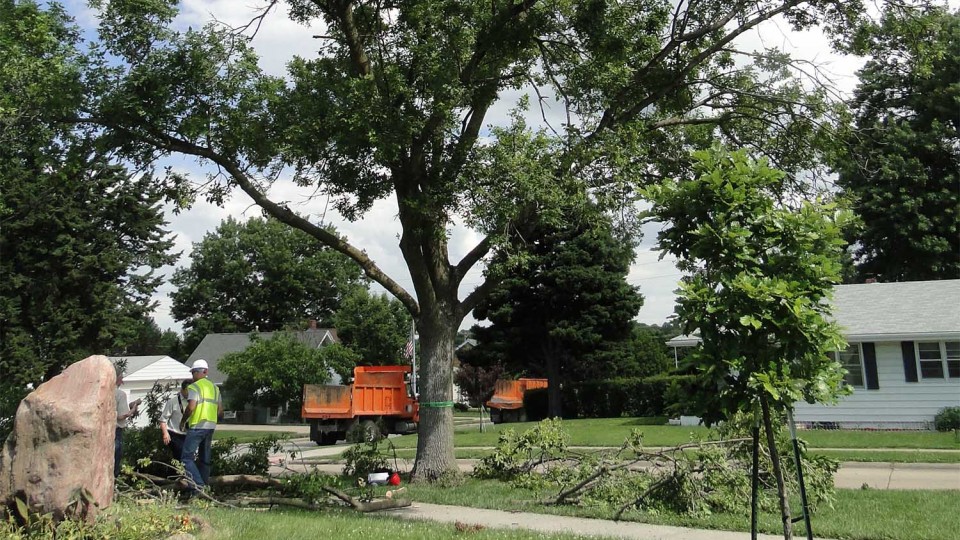
Experts from the Nebraska Forest Service, Backyard Farmer and Nebraska Extension are urging homeowners not to prematurely rush into treating their ash trees after the recent discovery of the invasive emerald ash borer in an Omaha park.
"The recommendation is not to treat trees until it's known that the bug is within 15 miles of you," said Justin Evertson, green infrastructure coordinator with the Nebraska Forest Service.
The Nebraska Department of Agriculture confirmed June 8 that the emerald ash borer, which attacks and kills all species of North American ash trees, was found during a site inspection in Pulaski Park in south Omaha. Nebraska is the 27th state to confirm the presence of the insect species, and the state's taxpayers and homeowners are expected to spend more than $961 million on ash tree removal, disposal and replacement.
The current treatment consideration zone extends from Fort Calhoun to Plattsmouth and from Gretna to east of Council Bluffs, Iowa. Treating outside of this zone will result in unnecessary exposure of the environment to pesticides, experts say. For anyone outside of the treatment zone, it's important to take an inventory of ash trees and determine if it's worth the cost of treatment.
Ash trees have an opposite leaf pattern, which means that leaves, buds and stems are located directly across from each other. Ash leaves are compound and typically consist of five to 10 leaflets. On average, ash trees grow to between 50 and 60 feet tall.
A variety of treatments are available for controlling emerald ash borer, including trunk injections and soil treatment. Professionally applied trunk injections involve pressure-injecting an insecticide into holes spaced around the lower trunk. All injection methods cause some internal damage to the tree. In general, the smaller the hole and amount of product injected, the less damage to the tree. Soil treatment is applied as a drench, by injection into the soil and as granules. Treatment is taken up by the roots and carried throughout the tree. Distribution in large trees may be uneven, resulting in inadequate control.
The cost of treatment can range from $100 to $200 per application, depending on the size of the tree. Each of the treatment methods has advantages and disadvantages that should be discussed with a certified arborist.
While several factors come into play when deciding whether to treat a tree for emerald ash borers, the vast majority of ash trees are not worth treating, experts say. The best candidates are high-value, healthy trees properly sited in the landscape. If a homeowner in a treatment consideration zone wants to pursue treatment, it's important to contact a certified arborist because they will have access to a wider range of products.
In addition, the yearly window of time that is recommended for treating an ash tree is closing. Soil treatments applied after mid-June will no longer be effective enough to control emerald ash borers this year. Also, trunk injections after mid-June will have quickly diminishing effectiveness the later they are applied because any tunneling by the insects will block the movement of the insecticide and older emerald ash borer larvae in July and August are more difficult to kill. Instead of applying treatments in July and later, trees will see greater benefits if treated the next spring.
Experts remind homeowners that treatments are not a permanent solution and those outside of the treatment zone do not need to consider the option at this time.
"Treatment will not save the tree forever; it only extends the time until the tree dies from either the treatments themselves or is overcome by EAB," said Eric Berg, community forestry and sustainable landscape program leader with the Nebraska Forest Service.
The alternative is tree removal. Again, experts recommend contacting a certified arborist to examine the tree to determine whether it has emerald ash borers or another insect or disease problem. As trees are removed, they should be replaced with a diverse selection of trees to help avoid another significant loss of tree canopy when the next serious pest arrives, according to Evertson.
Many broadleaf trees are available as replacements for ash. More than 60 species of medium to large trees are adapted to eastern Nebraska, and at least 30 species can be grown successfully in the west. Experts encourage homeowners to visit their local city park or arboretum to see a variety of trees growing in the area.
For more information, including how to identify an ash tree and how to find a certified arborist, go to http://nfs.unl.edu/nebraska-eab.
By Haley Steinkuhler | IANR Media
Courtesy photo | Nebraska Forest Service
More details at: http://go.unl.edu/dv9e